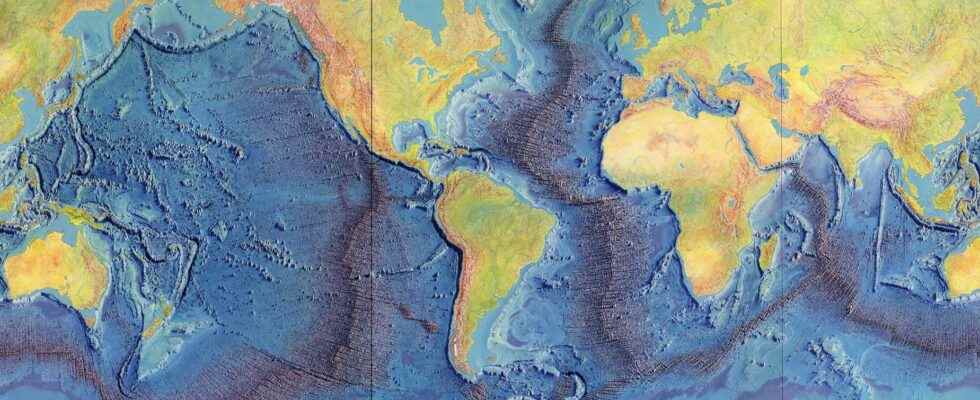You will also be interested
[EN VIDÉO] Earth’s history seen from space Since the end of the Second World War, Man has gained height and finally been able to admire the world he inhabits. From space, the Earth is beautiful, diverse and yet united, borderless. From up there, “we can see the fragility of the Earth,” said astronaut Thomas Pesquet. It’s an oasis in an ocean of nothing.
The ocean ridgestrue sutures between the lithospheric plates which make up the earth’s crust, represent the regions of the globe where the new oceanic crust. If the age of continental crust can reach in places almost 4 billion years, the maximum age of the oceanic crust is much lower. It currently does not exceed 200 million years, because of the process of subduction who recycles lithosphere ocean continuously since the formation of the Earth. In this dynamic system, the ridges represent the youngest areas of the oceanic crust.
An oceanic mantle and a subcontinental mantle of slightly different composition
The process of formation of the oceanic lithosphere is associated with the partial fusion of the coat underlying asthenospheric. Due to decompression adiabatic (rise at constant temperature) of the rocks of the mantle, these will begin to melt, but only partially, generating puddles Morb-type. This type of magma differs from type magmas OIB which come from the fusion of a deep mantle, inherited from the primitive mantle of the Earth.
The MORBs have, for their part, a composition impoverished in certain chemical elements (incompatible elements). This characteristic is the indicator that the upper mantle has already undergone previous episodes of fusion, and has notably participated in the formation of masses continents at the beginning of the Earth’s history. This depletion of certain chemical elements is observed even more markedly under the continents, the subcontinental lithospheric mantle being itself the source of the continental crust who overcomes it.
At the level of the mature ridges, which are located far from the continental margins, we thus find, almost exclusively, only igneous rocks of the MORB type, resulting from a mantle of oceanic origin whose composition is slightly different from that of the sub-continental mantle.
It may happen that fragments of this sub-continental mantle are torn off by various tectonic or magmatic processes and “contaminate” the asthenospheric mantle. However, oceanic rocks bearing the signature of a contamination by a very old lithospheric mantle, older than 2.5 billion years (age archaean).
New oceanic crust contaminated by old continental lithosphere
And yet, a team from the Chinese Academy of Sciences reports the discovery of peridotites, mantle rocks, showing the chemical signature of a 2.8 billion year old continental lithospheric mantle. A first, all the more exceptional as this discovery was made at the level of the south-west Indian ridge, which separates the plate Antarctic of the African plate.
This ridge, seat of the formation of the new crust of the South-West Indian Ocean, is located some 2,000 km from craton Archean age Kaapvaal, South Africa. The characteristic of this backbone is to have a very slow rate of expansionof the order of 14 mm/year and that the oceanic crust created there is often composed directly of mantle peridotites that have not undergone any fusion process. However, the analysis of certain samples of these mantle rocks exhumed at the level of the ridge shows that they were previously “contaminated” by the subcontinental mantle of the African craton.
But how did these very old rocks end up at the level of the current ridge? Thanks to digital modelsthe researchers show that it is certainly fragments of subcontinental mantle torn from the base of the African craton and recycled in the mantle to be reused at the level of the south-west Indian ridge.
The precise mechanisms of this process are still unclear, but scientists suspect that the fragments of Archean mantle could have been torn off by the rise of a plume of hotspot under the African continent, towards the end of the Cretaceous. The movements of convection of the mantle would then have made these fragments travel in theasthenosphere for tens of millions of years, until they reached the present Southwest Indian Ridge where they were punctured to form new oceanic crust.
These results, published in the journal Science Advancesencourage the revision of the processes of recycling of the continental lithosphere within the mantle, a mechanism certainly underestimated at present.
Interested in what you just read?
